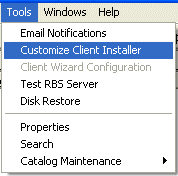 What's This?
What's This?Tools: Customize Client Installer
This section of the documentation has been depreciated. It is included for legacy systems only.
IMPORTANT NOTE: Beginning with version 11.10.00, the Client Customization Tool has been moved onto the Partner's Portal. No further updates will be made to the stand-alone customization and branding tool that was included with pre-11.10 versions. The stand-alone tool has been discontinued and will no longer be supported.
To customize and brand your client installers, log into the Partner's Portal at http://portal.remote-backup.com
Your RBS Software comes with a Server and a Client. The Client software should be customized for your Remote Backup Server before you distribute it.
You will use this section to customize your Client software so it looks and acts like you want it to when your customers install it. This is a very powerful function that allows you to fully brand your own RBS Client software.
This allows you to deliver a highly customized Remote Backup solution to a wide range of customers - from those who want to completely manage their own backups to those who want a simple one-touch set-and-forget solution with few options.
You can also create a customized self-installer (a single .EXE file or a Windows MSI installer) for your Client software at the touch of a button that can be distributed over the Internet or as an Email attachment.
Translating for Different Languages
The RBackup Client software comes in several languages. Changing the language changes the way some text appears on screen. The text that is affected by the Language setting is only the text that is not customizable otherwise - for the most part, the text that is hard coded in the software itself.
So, selecting a new language for the Client software will only change some of the text. The rest of the text must be changed manually by editing other files in the software system which contain phrases and words that are displayed on screen. These are the same files used to change the branding, described in this document under Customizing & Installing the Client Software.
Important Note About the Client's Help File: RBackup can be customized to such an extent that it no longer matches the default Client Help File in features, functionality, or appearance. For example, the default Client Help File shipped with the product contains the screen captions, "Remote Backup," and the default RBS Client icon. If you change those features, you may wantto re-capture all screens in the Help File that display them. If you lock out certain functions of the Client software using the Client Locks feature, you may want to remove references to the locked-out features from the Client's Help File.
For these reasons, the Client's Help File is not changed by the Language setting of the Client software. The Help File must be translated manually if you want it in a different language.
Please see the section on Editing the Client's Help Filein the Advanced Customizationchapter.
Note: The Evaluation Version can install both the Server and a pre-configured Client on the same computer. These instructions are for creating Clients to run on remote computers. This feature will not customize a Client that has already been installed.
Change the Company Name on program screens to your own
Change icons and program graphics to your own
Change the Splash and About screens to your own
Include your own End User License Agreement in the installer
Add a custom menu option and link to the Help menu
Customize the text in the Print Key form
Set the Client to contact only your RBS Server
Lock out parts of the Client's functionality so customers cannot change settings
Assign Backup Set schedule defaults
Pre-select file sets to back up (by file type)
Include your own custom file types
Define Autoselect file sets
Change Admin password
Change port number
Set File Retention Policy
Set Encryption Method
Set Compression Level
Set Transfer Verification Method
Set Processing Priority
Set Temporary File Path
Set BitBackup Reference Cache path
Turn ON or OFF the "Install Client as Service?" prompt during installation
Set default Log Levels and Log Retention Period
Set various program internal values
This section of the documentation has been depreciated. It is included for legacy systems only.
IMPORTANT NOTE: Beginning with version 11.10.00, the Client Customization Tool has been moved onto the Partner's Portal. No further updates will be made to the stand-alone customization and branding tool that was included with pre-11.10 versions. The stand-alone tool has been discontinued and will no longer be supported.
To customize and brand your client installers, log into the Partner's Portal at http://portal.remote-backup.com
The Basic Settings Tab contains the most basic of options that must be set to make the RBS Client software connect to the RBS Server.
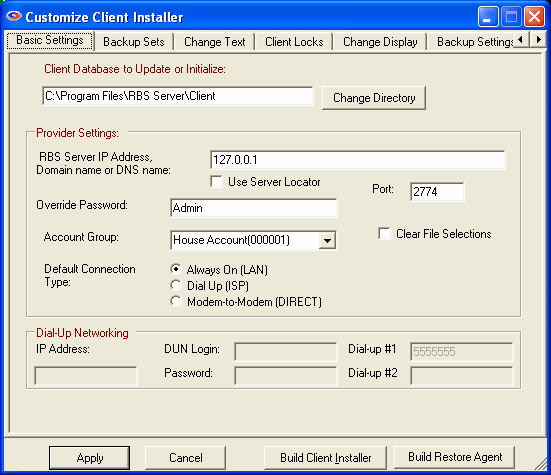
If your clients are using Always On or ISP, enter the RBS Server's IP Address or Domain Name here. If your clients will be using a direct dial-up connection to your backup server, you can leave this field blank. If you select Use Server Locator, your SL Host Name will automatically be entered here. Read more about the Server Locator HERE.
You can enter as many as 32 IP addresses or Domain Names here representing 32 RBS Servers, separated with semicolons, as long as the total length of the input does not exceed 255 characters. The Client software will try the Servers in sequence until one of them answers. This is useful if you have two mirrored RBS Servers operating as fail-overs, or multiple RBS Servers sharing a common drive:
server1.domain.com;server2.domain.com;myfailover.com
In the Evaluation version, enter your RBS Server's PUBLIC IP ADDRESS here to create clients that can connect from OUTSIDE your network. Enter its PRIVATE IP ADDRESS to create clients that can connect from INSIDE your network.
You can see your Public IP Address on the RBS Web Site. Go to http://remote-backup.com/support/
Select this checkbox if you will be using the Server Locator to route your clients. This is usually the preferred option. Please note that the Server Locator, a service provided as part of your Maintenance Subscription, may not work if your Maintenance Subscription lapses.
Some features of the Remote Backup Client can be changed only after entering an override password. Pick your override password and enter it here. Please note that this is CASE-SENSITIVE. This password is used at the Client to change Administrator's features.
Select your preferred initial Connection type for the client.
Always On (LAN) - The Client will connect to your RBS Server using an always-on connection like Cable Modem, DSL, or company network. Use this selection if your client is on a corporate network or other network which has a full-time Internet connection, OR is connected through any kind of network where the Client computer does not have to directly manage the Internet connection. This is the default connection type for the vast majority of users.
Dial-Up (ISP) - The Client will connect to your RBS Server through the Internet using a Dial-Up telephone modem using a connection to his Internet Service Provider (ISP). The client will need to select the current ISP Dial-up Icon from the client Options form on the Connections tab.
Modem-to-Modem (DIRECT) - The Client will use its telephone modem to directly dial your RBS Server computer's telephone modem, without going through the Internet. This rarely-used option is included for legacy clients and for Service Providers in areas of the world that do not have reliable Internet connections. Remote Access Server (a Microsoft Windows component) is required at the RBS Server.
Checkmark this selection if you want to load default file selection settings into your Client installer. Leave it unchecked if you have made modifications to the Include and Exclude selections, the schedules, the AutoSelect state, or any of the Backup Sets in your default backup.mdb file.
Select the House Account that you revised in the earlier step to Stamp' that account into the distribution database. For more information on Account Groups, see the RBS Server Documentation.
Note:The following entries are for use only with direct dialup connections between clients and server using telephone lines, and not the Internet.If you are not going to accept direct telephone modem connections between your clients and your Server, you can use the defaults for every field in the "Dial-Up Networking" box at the bottom of the screen. The next four entries are not needed unless you are providing direct computer-to-computer, non-internet service and have selected Modem-to-Modem (DIRECT) as the Connect Type.
These rarely-used options are included for legacy clients and for Service Providers in areas of the world that do not have reliable Internet connections. Remote Access Server (a Microsoft Windows component) is required at the RBS Server.
If your dial up server is Windows 98, a dial-up login is not used. Enter na in this field. If your dial up server is Windows NT, Windows 2000, or a 3rd party program, enter REMOTE BACKUP
Enter the password used by your dial-up server. This is the same password you entered when you installed Windows' Dial-Up Server features.
Enter the telephone number your clients will dial to reach your Server. This number can be left blank if you are using the Internet.
If you are using a secondary telephone number as a backup number, enter it here. This number can be left blank if you are using the Internet.
Click the Apply button to apply the changes you have made.
For information on creating your Client installers, see Creating Client Installers.
This section of the documentation has been depreciated. It is included for legacy systems only.
IMPORTANT NOTE: Beginning with version 11.10.00, the Client Customization Tool has been moved onto the Partner's Portal. No further updates will be made to the stand-alone customization and branding tool that was included with pre-11.10 versions. The stand-alone tool has been discontinued and will no longer be supported.
To customize and brand your client installers, log into the Partner's Portal at http://portal.remote-backup.com
Use the Backup Sets tab to pre-define the default backup sets that you will distribute with your RBS Client installer. Select the Backup Set you want to work with from the drop-down menu at the top of the screen, or create a new set by selecting the Create New Set button. You can also delete a backup set by selecting the Delete Set button.
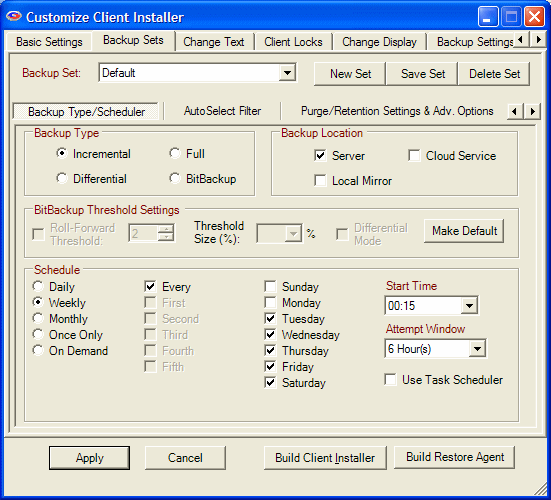
This is where you define the dates and times for your Backup Sets to run. This screen contains a box called Backup Type, which is where you select the type of backup this Backup Set will run.
Entire files will be backed up which have been modified since the last backup. Then, after they are backed up, the files will be marked on the disk as having been backed up. This is the default and most widely-used way to back up data files.
Entire files will be backed up which have been modified since the last backup, the same as Incremental. However, after the files are backed up, they will not be marked as having been backed up. The reason for this option is in case you also want to do tape backups as well as remote backups. Your tape backup software relies on the marks placed on the files to determine which files need to be backed up. So, you don't want to remove them with your Remote Backup.
Entire files will be backed up regardless of whether they have been changed since their last backup. This is the least-used option because it results in the largest Backup Sets and longest on-line times.
Only the parts of files that have changed will be backed up. This option creates sub-file or "patch" backups. This creates the smallest backups that take the least amount of time, and is the recommended default setting. For more information on how BitBackup works, see How BitBackup Works.
Select the location for this backup. You can select from Server, Local Mirror, and/or Cloud Backup. You can select any or all of these. Backups will be sent simultaneously to the selected locations.
Server - The backup will be sent to the RBS Server.
Local Mirror - The backup will be sent to the Local Mirror location as defined in Options : Local Mirror Options.
Cloud Service - The backup will be sent to a drive or folder mapped to a Cloud service like Google Drive or DropBox as defined in Options : Cloud Backup Options.
BitBackup is a special kind of backup that backs up only the changed parts of files instead of the full files. It is sometimes called "sub-file" backup or "patch" backup. BitBackup is especially useful for very large files when only small parts of the files change between backups. For a complete explanation, see How BitBackup Works.
For example, if only a five-character word changes in a 2 megabyte document, BitBackup will back up only five characters. This can save large amounts of storage space on the Server, and it can significantly speed up the time needed to do a backup.
BitBackup always backs up a full file the first time. Thereafter, it backs up only the changed parts of the file. Each of the BitBackup backups sent after a full backup can restore the file up to the point in time when that backup was done, called cumulative backups. So, as time goes on, BitBackup archives become larger as they contain more changes.
Periodically, BitBackup needs to reset - a process called Roll-Forward. To do this, Remote Backup sends the full file again, and then resets BitBackups, which reduces their file size back to the minimum. This process cycles according to the settings at the bottom of this screen.
This is the number of BitBackups that will be done before Remote Backup resends the full file again.
The percentage of BitBackup size to full-file size. In the example on this screen, when the size of the most recent BitBackup archive exceeds 50% of the size of the full file, Remote Backup will perform a Roll-Forward, re-sending the full file.
Using the Threshold Size feature instead of the Roll-Forward Threshold setting takes more time during preparation of a backup, because Remote Backup needs make a BitBackup archive to compare its size to the full file.
Select this checkbox to set a Backup Set defined as BitBackup to operate in Differential Mode. Differential Mode in BitBackup operates the same way as Differential Mode for entire files, except that with BitBackup only the parts of the files that have changed are transmitted to the RBS Server. Archive bits are not reset. This setting is useful if you need to coordinate your Remote Backups with local Tape backups.
Click the Make Default button to make all the settings on this sub-tab the defaults for all new Backup Sets created by the Client.
This is where you can select different schedule types.
Selecting this option will launch a backup every day, seven days a week.
This schedule lets you select which days of the week to do a backup.
On this schedule you can select the first, second, third, fourth or fifth of any day of the week. Here are some examples: You can pick the first and third Wednesdays of each month. You can select the second Tuesday and Thursdays. There are a lot of possible schedules you can use here.
This schedule will launch a single backup session, one time only, on a specified date you can pick from a pull-down menu containing a calendar.
Pick this selection if you want this backup set to be launched on demand only - not through the scheduler. You can then launch this backup set through the Run: Run Now menu choice in the Client software. You can also run it through Windows Scheduled Tasks.
For each of these schedules you can select a Start Time and an Attempt Window. It is important to remember that the Start Time is on a 24-hour schedule, and that anything after midnight is the next day. This means that if you want to back up Friday's work, and you want the backup session to take place after midnight, you should select a time early in the morning of Saturday, not Friday.
The Attempt Window is the number of hours Remote Backup will attempt to perform the backup. Selecting a start time of, for example, 1:00am will not necessarily cause the backup session to start at 1:00am, although it might. Remote Backup might not be able to perform a backup for a variety of reasons - the Server is too busy, files are locked, the computer isn't turned on.
In the event that Remote Backup can't perform a backup at the selected Start Time, it will attempt the backup session some time during the next period of time determined by the number of hours you select here.
Select this checkbox to use the Windows Task Scheduler to launch this backup set instead of using RBackup's built-in scheduler. Some applications have the potential to interfere with RBackup's built-in scheduler, especially when RBackup is running in Service Mode. It is generally considered more reliable for wide-scale distributions to use the Windows Task Scheduler.
Use this tab to pre-select sets of files to back up or exclude from backups in the currently selected Backup Set.
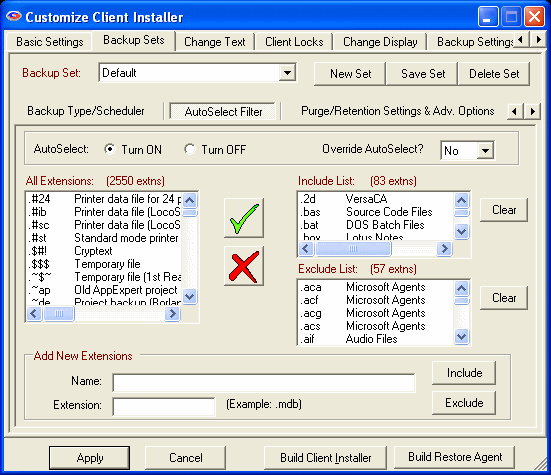
RBackup has two basic ways to select files - Manual file selection and AutoSelect.
Manual file selection is used when you want to back up a specific folder or file. You simply Include (with a green checkmark) or Exclude (with a red X) specific folders and files.
AutoSelect can back up files by file type regardless which folder they are in. For example, if you want to back up all Microsoft Word document (.doc) files, you can select the .doc file extension in the AutoSelect menu. Remote Backup will scan the entire file system (or just selected parts of it) and will back up Microsoft Word document files wherever they are found.
AutoSelect is especially useful for quick, end user installations when files are not kept strictly in specific folders.
AutoSelect can be turned ON or OFF for each Backup Set. To turn it ON, select Turn ON. To turn it OFF, select Turn OFF.
By default, AutoSelect scans all hard drives that are not specifically excluded by a Red X, beginning at the root of the drive and working its way through all folders. You can override this behavior and make AutoSelect scan only folders that are selected with a Green Checkmark. This will speed up the scanning process and limit file selection, at the expense of missing files that are not in the included folders.
You may want to do this if your users will be backing up only files contained within certain folders, like My Documents. It could shorten backup times and lower the amount of storage space required.
To override AutoSelect's default method of scanning all attached drives, and have it scan only folders marked with a green checkmark, select YES for Override AutoSelect.
To pre-select file types to back up, simply select the file type from the List Of All Extensions list, and click the green checkmark to Include the file type, or the red X to Exclude the file type.
If you don't find file type you need in the List Of All Extensions, you can add it yourself using User-Defined Extensions.
When you are finished editing the AutoSelect Filters, click the Apply button.
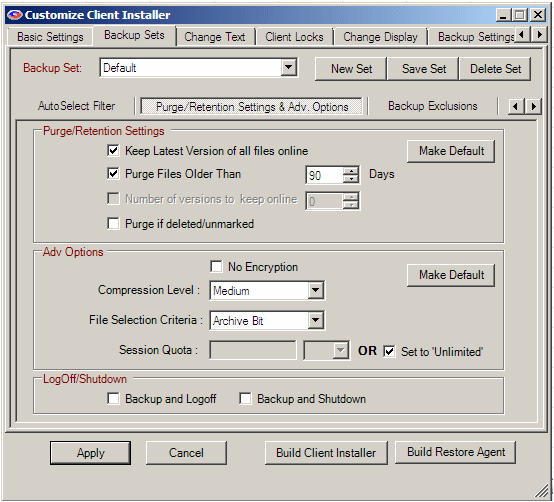
The Purge/Retention Settings & Adv. Options sub-tab contains the following settings:
Check this setting if you want to keep the most recent version of a file. For example, assume you have set Purge Files older than to 30 days. If you only have a single copy of a file within that time frame, and you do not checkmark this option, that file will be erased when its age is over 30 days. If you checkmark this option, that file will be retained regardless of its age until a more recent one appears at your RBS Server UNLESS you also select Purge if Deleted/Unmarked, see below.
Use this setting to set the retention period of the files in this Backup Set to a number of days. In this example, files will be retained for 30 days and then erased from the RBS Server.
When Purge Files Older Than is not selected, this option becomes available. You can select a number of backup sets to keep online, and have the Client software delete old backup sets (all the files in a backup set) in a First-In-First-Out method. For example, if you have this set to 7, when the 8th Backup Set is stored, the oldest backup set will be deleted.
Select this checkbox to automatically delete files from the Server at the end of their retention period if they are deleted from the Client or if they are deselected (unmarked) by the Client. Please note that this setting overrides the Keep Latest Version setting, above. If Keep Latest Version is selected, and Purge if Deleted/Unmarked is also selected, files that are deleted from the Client or are deselected by the Client will be deleted.
Set the desired compression level for the files in this backup. Normally, leave this at Medium unless instructed to do otherwise by an RBS technician.
This sets the way RBackup selects files for backup.
If set to Archive Bit, RBackup will select files that have changed since the last backup, according to the archive setting for the file. This is a very fast way to select files. However, if another program resets the archive bit before the backup, the file might not be selected for backup.
Setting the File Selection Criteria to Modified Date/Time has two advantages and one disadvantage: It can select files for backup regardless of the archive bit, so it's generally more reliable; and it will always do a first full backup, then automatically switch to Incremental Mode (a very handy feature). Its disadvantage is that during a backup session the file selection process is slower than using the archive bit - sometimes quite a bit slower. This might not matter, however, if backups are done at night when nobody is using the computer.
This method is designed to speed up the Scanning process (or File Selection process), especially in cases where there are many thousands of files to scan, (greater than 50,000) and where Archive Bit Selection is not appropriate.
Fast Pick relies on the last successful backup's Date/Time Stamp. For the first backup, Fast Pick will always do a full backup. For subsequent backups, files that have been added or changed since the last backup (selected by date/time) will be backed up.
This method of selection is useful when you are backing up a file sever (for example) that has many thousands of files that need to be scanned, or in cases where archive bit cannot be used for file selection (like a Samba/Linux box).
IMPORTANT: If, after the initial backup using Fast Pick, you make changes to File Selection, (include a new file or folder to backup), the Modified Date/Time must be reset for these new inclusions. Otherwise, these files will not be selected for backup. If users change file selections with Fast Pick turned on, they will be prompted to change the date, and the software will do it for them.
You can set a limit on the amount of data an individual Backup Set can send to the Server in a single session. You might want to do this to limit a first backup from a Client who has a large amount of data, so that it sends the first backup over a series of backup sessions rather than all at once. You can also use this to help define different backup plans for sales and pricing purposes. Select the Session Quota in megabytes or gigabytes, OR set the Session Quota to Unlimited with the checkbox.
You can set the Client computer to either log off the current user or shut down the computer at the end of the backup session.
For information on creating your Client installers, see Creating Client Installers.
This tab is used to set default Exclusions for the selected backup set. Default Exclusions are files and folders that cannot be selected for backup, and do not appear in the file view. Files and folders are excluded based on wildcards and Virtual Folders, and are customizable by backup set.
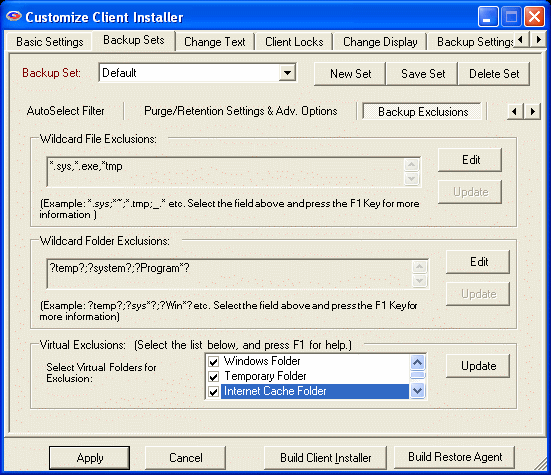
Use this option to exclude files using Wildcards. Separate exclusions with semicolon (;).
File and folder names are not case-sensitive. Click on Edit to add wildcards. To save, click on Update.
Note: Files that match these wildcards will NOT be displayed on the client interface.
This feature accepts the following formats:
Files starting with: (Format: starting {chars} of the filename followed by *)
Examples:
~* This will exclude all files whose filename starts with tilde (~).
Temp* This will exclude all files whose filename starts with ‘Temp’.
Files ending with: (Format: * followed by ending {chars} of the filename)
Example:
*temp This will exclude all files whose filename ends with ‘temp’
By file extension: (Format: * followed by a period (.), then the file extension)
Example:
*.sys This will exclude all files with .sys extension.
By Wildcards: (Format: * followed by {chars} to match, and then ending with a *)
Example:
*tmp* This will exclude all files whose filename has the string ‘tmp’
Use this option to exclude folders using Wildcards. Separate exclusions with semicolon (;). Not case-sensitive. Click on Edit to add wildcards. To save, click on Update.
Note: Folders that match these wildcards will NOT be displayed on the client interface.
This feature accepts the following formats:
Folders that exactly match with: (Format: ? followed by ‘foldername’ followed by ?)
Example:
?Windows? This will exclude files where the folder name matches ‘Windows’ anywhere in the entire file path.
Folder name starts with: (Format: ? followed by starting chars of folder name followed by *?)
Example:
?Sys*? This will exclude files where the folder name starts with “sys”
Folder name ends with (Format: ? followed by * followed by ending chars of folder name followed by ?)
Example:
?*32? This will exclude files where the folder name ends with “32”
Folder name LIKE: (Format: ? followed by * followed by chars to match followed by * followed by ?)
Example:
?*temp*? This will exclude files where the folder name is LIKE “temp” anywhere in the file path.
Use this section to select standard Windows virtual folders for exclusion. Virtual Folders are folders that might not have the same name from computer to computer, but are defined by these virtual names.
Select the following virtual folders to exclude from backup:
Note: Virtual folders marked for exclusion will NOT be displayed on client interface.
Windows Folder
C:\Windows or C:\Winnt
Temporary Folder
System Temp folder. Example: C:\Documents and Settings\Administrator\Local Settings\Temp
Internet Cache Folder
Temporary Internet Files: C:\Documents and Settings\Administrator\Local Settings\Temporary Internet Files
System Folder
Windows System folder. Example: C:\Windows\system32
Cookies Folder
Cookies folder. Example: C:\Documents and Settings\Administrator\Cookies
History Folder
Example: C:\Documents and Settings\Administrator\Local Settings\History
Application Data Folder
Example: C:\Documents and Settings\Administrator\Local Settings\Application Data
To edit these exclusions on the client end, select Options: Preferences and unlock the padlock with Admin Override password. Then select ‘Admin Options’ and you will see a tab called ‘Edit Backup Exclusions’. (as shown below)
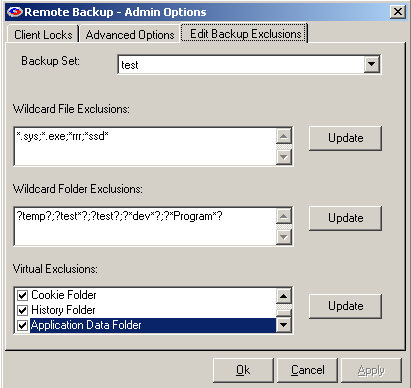
This section of the documentation has been depreciated. It is included for legacy systems only.
IMPORTANT NOTE: Beginning with version 11.10.00, the Client Customization Tool has been moved onto the Partner's Portal. No further updates will be made to the stand-alone customization and branding tool that was included with pre-11.10 versions. The stand-alone tool has been discontinued and will no longer be supported.
To customize and brand your client installers, log into the Partner's Portal at http://portal.remote-backup.com
This tab contains settings that can change various text elements in the RBS Client software.
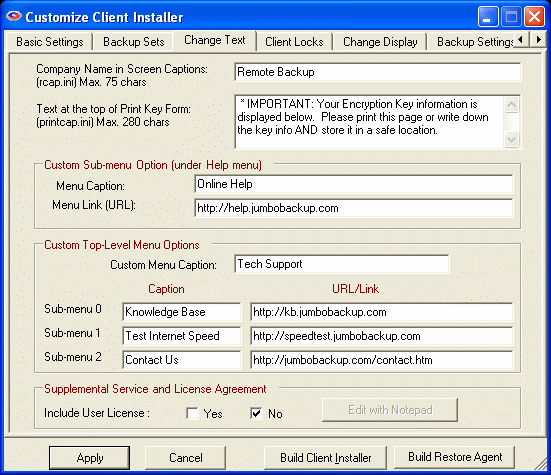
 Company Name in Screen Captions
Company Name in Screen CaptionsEnter your own company name here. It will replace the words "Remote Backup" in the screen captions.
When the RBS Client software is installed, and whenever the user changes his encryption key or any other parameters that might affect his ability to restore, the software displays a form containing the new information, with instructions to print the form. You can change those instructions here.
You can add your own menu item to the Help menu here. Enter the name of the menu item you want to add. Example: DataSafe Technical SupportWeb Site
Enter the URL for the user's browser to go to when the Menu Caption is clicked.
 Custom Menu Caption
Custom Menu CaptionYou can include your own custom top-level menu with three menu choices on the RBackup screen to the right of the Help menu. Each of the menu choices can link to a URL. Enter the name of the custom menu here.
Enter the menu choices here as you want them to appear on the menu in the Caption field, and the URL for each menu choice in the URL/Link field.
Select either Yes or No to include your own License Agreement.
Your License Agreement is a text file called userlicense.txt. It is in the \RBS Server\Client\ folder, and if you have the Online Installer, it is also in the \RBS Server\Web\OnlineInstaller\ folder. It is displayed just after the Standard Software License Agreement in the Client Installer.
This file should be created and edited with Notepad - NOT Word or Wordpad, or anything else that creates a different type of file. This file is a standard TEXT file with a .txt extension.
If this file does not exist, the Client installer will skip the associated screen. This screen is called, "Supplemental Service and License Agreement." The installer will handle this license screen as it does with the previous screen, called "Standard Software License Agreement." A user MUST answer "Yes" to this screen in order to install the software.
The userlicense.txt file can be dynamically generated by a web-based sign-up system, just as any of the other provider-configurable files can be. So, it can contain SPECIFIC prices and service levels defined by the specific plan selected by your user when he signs up.
The installer will display userlicense.txt with automatic word wrap, as long as you edit it without hard carriage returns except for two between each paragraph.
If you intend to use the userlicense.txt file with the Online Installer PlugIn, upload it to your web server in BINARY MODE so the carriage returns at the ends of the paragraphs remain intact. Uploading it in TEXT mode may cause the paragraphs to display improperly. Some FTP clients automatically switch into TEXT mode when uploading files that end in the .txt extension.
This section of the documentation has been depreciated. It is included for legacy systems only.
IMPORTANT NOTE: Beginning with version 11.10.00, the Client Customization Tool has been moved onto the Partner's Portal. No further updates will be made to the stand-alone customization and branding tool that was included with pre-11.10 versions. The stand-alone tool has been discontinued and will no longer be supported.
To customize and brand your client installers, log into the Partner's Portal at http://portal.remote-backup.com
This tab contains the client locks. You can lock out certain features of the Client software, preventing end users from using them. For example, if you don't want clients to be able to change backup schedules or change file selections, select Lock Scheduler Window and Lock Ability to Change/Add File Selection.
Client Locks are useful when you want to distribute a pre set-up version of the Client software with few options. This allows you to better control your costs and reduce support issues associated with users who might misconfigure the software.
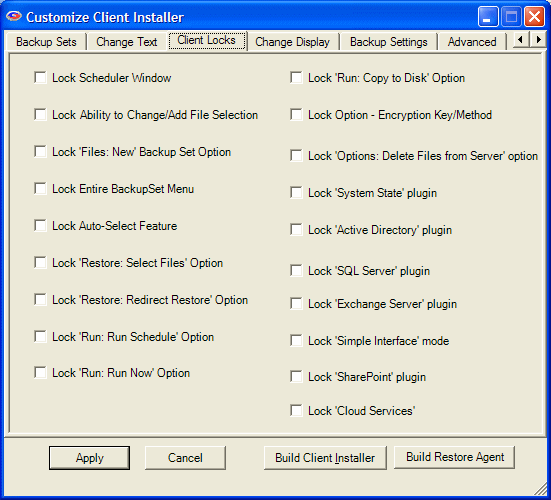
This section of the documentation has been depreciated. It is included for legacy systems only.
IMPORTANT NOTE: Beginning with version 11.10.00, the Client Customization Tool has been moved onto the Partner's Portal. No further updates will be made to the stand-alone customization and branding tool that was included with pre-11.10 versions. The stand-alone tool has been discontinued and will no longer be supported.
To customize and brand your client installers, log into the Partner's Portal at http://portal.remote-backup.com
This tab lets you change the graphical elements of the Client software to further brand it as your own. You can replace the Splash and About screens, the shortcut icons, the program icons, and the system tray icons. You can also replace the red X and the green checkmark with your own graphics.
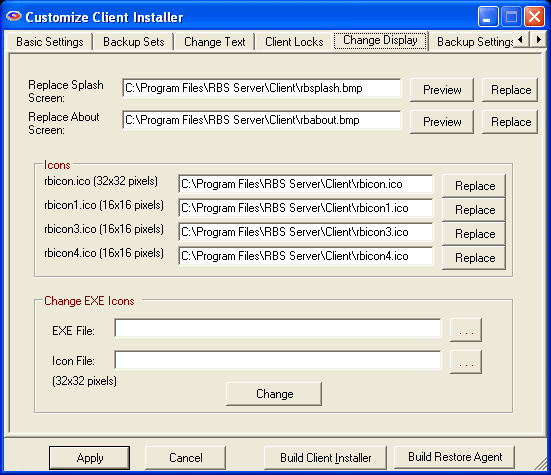
The Splash and About screens are standard graphics files in Windows bitmap format (.bmp) on the Client installation disk. You can change these screens by using a standard graphics editor to edit the files.
Do not change the dimensions of the graphics. The Client software relies on them being this size.
This graphics are displayed on a white background when the Client software starts, with the Remote Backup Systems copyright notice across the bottom.
Do not change the file names, file types, or graphic types, otherwise the Client software will not display them properly.
The name of the Splash screen file is: rbsplash.bmp. The name of the About screen is rbabout.bmp. These files are located in one or two places, depending on whether you have the Online Installer PlugIn.
All RBS Servers have these files in the Client installation folder in the main working folder for the Server, which is typically called Program Files/RBS Server/Client/
If you have the Online Installer PlugIn, you will also have the files in the Online Installer folder, C:Program Files/RBS Server/Web/OnlineInstaller
To change the graphics files, copy the original files from their default locations (indicated on this screen) and edit them. To replace the original files, pick the Replace button and follow the instructions.
You can change the default icons and graphics that display inside the Client software. These are the graphics that show up on the System Tray, on the Captions of the screens, within the screens, in Add/Remove programs, and in Windows Explorer.
Replace the following files with your own, and include them in the Client's Installation file set:
 rbicon.ico
rbicon.icoThis is a standard .ICO file type, 32x32 pixels. This icon will show up in the captions of all the screens.
 rbicon1.ico
rbicon1.icoThis is a standard .ICO file type, 16x16 pixels. This icon shows up in the System Tray and in the Add/Remove Programs interface.
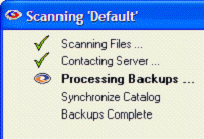 rbicon3.ico and rbicon4.ico
rbicon3.ico and rbicon4.icoThese are standard .ICO file types, 16x16 pixels. They are usually the mirror image of one another, and are used in progress screens by swapping them back and forth, which makes them appear to move, indicating progress.
The program files installed as part of the Remote Backup Client software contain icons which Windows uses in various places, such as Windows Explorer, Add/Remove Programs, and other management interfaces. The program file names end in the file extension, "EXE"
Note: The icon files replaced here MUST be 32x32 pixels.
Note: Some of the EXE files that might exist in the Client's installation set are provided by other vendors who use a different technology for storing icons inside their EXE files. In those cases, you may not be able to change the icons in those files.
You can replace the icons inside these EXE files using the "Change EXE Icons" section on this tab.
Select the EXE file you want to change then select the Icon File (ending in .ICO) you want to place in the EXE file, and select the Change button.
There are at least two EXE files in the Client's installation file set that you will want to change - rbclient.exe and rbackup.exe. There may be more, depending on which version of RBackup you have, and which PlugIns.
This section of the documentation has been depreciated. It is included for legacy systems only.
IMPORTANT NOTE: Beginning with version 11.10.00, the Client Customization Tool has been moved onto the Partner's Portal. No further updates will be made to the stand-alone customization and branding tool that was included with pre-11.10 versions. The stand-alone tool has been discontinued and will no longer be supported.
To customize and brand your client installers, log into the Partner's Portal at http://portal.remote-backup.com
The Backup Settings Tab contains options that apply globally to all backup sets.
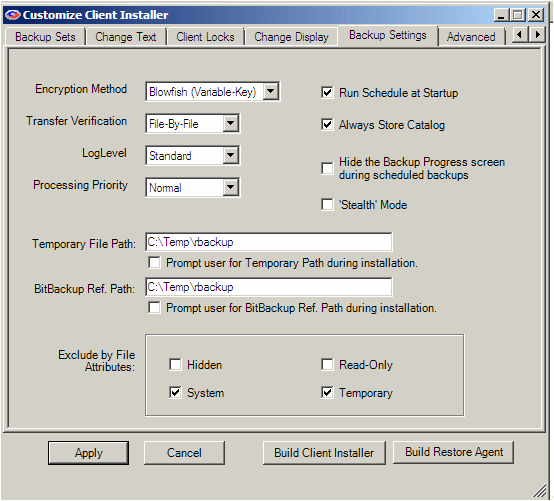
Select the default encryption method. For more information on the various types of encryption, see the section on Encryption Standards.
This is the method that RBackup uses to verify files after they have been stored on the RBS Server.
File-By-File verifies every file individually after it has been stored on the RBS Server. This method is safer than At-End, and supports RBackup's Resume Mode, which will resume a backup in mid-file if the Internet connection goes down before its transfer is complete. File-By-File results in slower backups than At-End because of the additional processing that happens between files.
At-End verifies an entire batch of files at once. This results in faster backups than File-By-File, but does not support Resume Mode. If an Internet connection fails in mid-transfer, RBackup will re-send the entire interrupted file from the beginning. In some cases this is desirable, but in most cases, use the File-By-File transfer verification method.
This selection is for fine-tuning RBackup with Remote Backup Systems' Tech Support staff. Use it only at the recommendation of RBS, unless you know how to read the more detailed (and much larger) versions of the logs. Unless otherwise advised, this should be set to Standard.
This selects the priority given to backup tasks by the CPU. A lower priority slows down processing, but gives higher priority to the other tasks running on the Client computer.
This is the compression level RBackup will use to compress files before sending them to the RBS Server. Normally this should be set to Medium. Setting it to Low might save a little time during processing, but will increase the time required to store the file on the RBS Server. Setting it to High requires more time during processing and does not usually result in much quicker file storage times.
Select this option to have the Client start automatically with Windows, and activate its scheduler. The default for this option is ON.
Select this option to have RBackup back up the Client's catalog to the RBS Server even if there are no files to back up.
Select this option to hide the screen that displays progress during backups. This is good if you want the Client to do backups without interrupting his other programs with a display screen.
Select this option to have the Client run with no screens at all, including no startup screens.
This is the location on the Client's hard drive where temporary files are stored during backup processing.
The location of the BitBackup Data Store. BitBackup stores a copy of all the files selected for backup using the BitBackup method (on the Schedule Screen). The space required for this storage space is the total native file size of all files for which BitBackup has been selected.
Here you can select up to four common file types that rarely need to be backed up. This will reduce storage requirements and online time. We recommend you select all of them.
This section of the documentation has been depreciated. It is included for legacy systems only.
IMPORTANT NOTE: Beginning with version 11.10.00, the Client Customization Tool has been moved onto the Partner's Portal. No further updates will be made to the stand-alone customization and branding tool that was included with pre-11.10 versions. The stand-alone tool has been discontinued and will no longer be supported.
To customize and brand your client installers, log into the Partner's Portal at http://portal.remote-backup.com
The Advanced Tab contains seldom used features that control esoteric functions of the Client software.
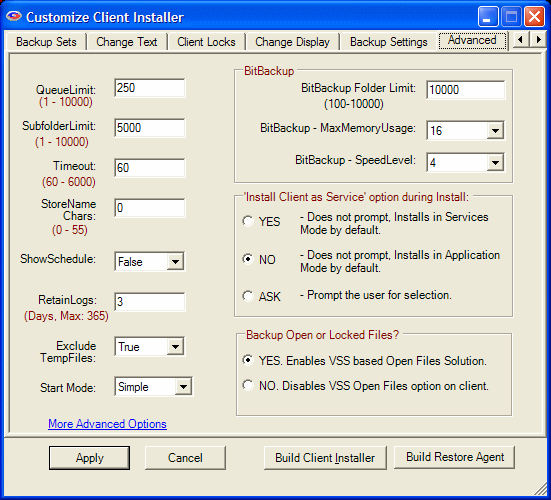
The number of files that will be processed before the next phase of the backup session is started. In this example, RBackup will process 250 files before beginning to upload them to the RBS Server.
The maximum number of files that will be stored in a single subfolder on the RBS Server. Sometimes it is desirable to set this option to 5000 or lower if backups are going slowly because of low resources on the RBS Server.
The number of seconds the RBS Client software will wait for a connection to the RBS Server during a temporary loss of the Internet during a backup session. When this value is exceeded, RBackup will close the connection and retry.
The number of characters from the original (native) file name that RBackup will append to the Archive file name and store on the RBS Server. For security reasons, the normal setting for this is 0 (zero), which means that none of the original file name is visible. RBS Archive files then have names like this:
200705031388.558635430000000060560000000267.001
However, if you need to display the original file name for data management purposes, you can set this option to display the file name, as in this example where StoreName Chars is set to 21:
Budgetary_Spreadsheet200705031388.558635430000000060560000000267.001
Set this option to True to display upcoming backup schedules in a small window near the System Tray. Set it to False if you do not want to see the schedule.
This option determines how long session logs are retained. If it is set to 7 days, session logs will be erased when they are more than 7 days old.
This option causes RBackup to skip Temporary Files that end in .TMP. Unless instructed by an RBS Technician, set this to True.
Select Simple to start the RBackup Client software in Simple Interface Mode, or Advanced to start it in Advanced mode. More information on User Interface Modes here.
This is the maximum number of files that RBackup will maintain in a single folder in its Data Store. If BitBackups are going too slowly, consider reducing this number. Normally, 10,000 is the largest number of files you should select, and 5,000 is about normal.
Give BitBackup as much memory as possible. 16 is average. Lower the number in the rare case that the computer displays "Not enough Memory" messages during BitBackups.
This option specifies the speed at which BitBackup creates its patch files. The higher the speed, the more CPU time BitBackup requires. The default is 4.
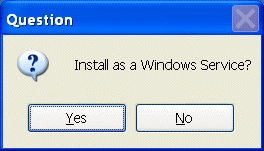 "Install Client as Service" option during Install:
"Install Client as Service" option during Install:By default, the Client installer detects the Windows version it is running on. If it is running on a version that supports Windows Services, it will display the Install as a Windows Service? prompt.
By default this option is set to YES, so the Client software backs up open and locked files. If you do not want the Client software to back up open and locked files, select NO here.
VSS works only on Windows XP and newer operating systems. It will not work in Windows 2000 or Windows NT.
The Client software uses Windows' VSS (Volume Shadow Copy) to back up open files. VSS requires enough space on the hard drive to cache a copy of all open files during the backup. The cache will be deleted at the end of the backup.
This section of the documentation has been depreciated. It is included for legacy systems only.
IMPORTANT NOTE: Beginning with version 11.10.00, the Client Customization Tool has been moved onto the Partner's Portal. No further updates will be made to the stand-alone customization and branding tool that was included with pre-11.10 versions. The stand-alone tool has been discontinued and will no longer be supported.
To customize and brand your client installers, log into the Partner's Portal at http://portal.remote-backup.com
The More Advanced Options link contains the following features.
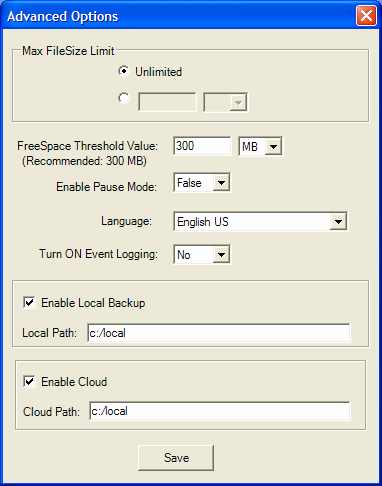
Many Service Providers set a maximum file size for their customers' backups. Four gigabytes is a typical file size limit. Files bigger than this number will be excluded from backups. This applies only to stand-alone files, and not to databases like Exchange, SQL Server, Active Directory, Sharepoint, and it does not apply to System State.
During backups, especially when BitBackup is selected, the RBackup Client software uses some local drive space as temporary work space. In particularly large backup sets on drives with too little free space the temporary work files can become too big for the drive. This setting is the amount of free space on the hard drive that will cause the software to stop processing and record an exception in the log rather than simply running out of drive space.
This setting enables the "Pause" button on the Progress screen.
This sets the default language of the Client software's Simple Interface. Additional translation will have to be done using the Text Replacement features of the Customize Client Installer. The Advanced Interface is not localizable.
This turns on the RBackup Client software's ability to write to the Windows Event Logs. See Event Logging for more information.
This turns on the RBackup Client's feature that maintains a local mirror copy of everything it sends to the RBackup Server. The local mirror is usually maintained on a USB drive or network attached drive. During restore the RBackup Client software looks for its files first at the Local Backup location and restores from it if they are available.
Enter a "dummy" path here, like "F:\" unless you know the path to the local storage device at the time you customize your client installers.
This turns on the RBackup Client's feature that backs up to a third party Cloud backup service like Google Drive or DropBox. The Client will send a copy of everything it sends to the RBackup Server, encrypted and compressed, and without filenames to maintain HIPAA compliance. To use this feature the end user must have an account with a third party service that provides a mapped drive letter or folder on the Client's computer. Point the Cloud Path (below) to that location.
This is the path or drive letter of the folder or drive mapped to a third party Cloud backup service.